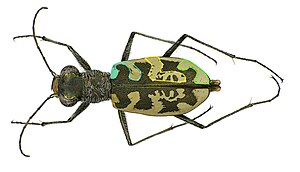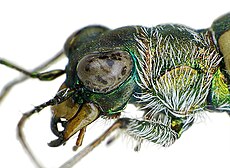Cephalota circumdata
| Cephalota circumdata | ||||||||||||
|---|---|---|---|---|---|---|---|---|---|---|---|---|

Cephalota circumdata leonschaeferi |
||||||||||||
| Systematics | ||||||||||||
|
||||||||||||
| Scientific name | ||||||||||||
| Cephalota circumdata | ||||||||||||
| ( Dejean in Latreille & Dejean, 1822) |
Cephalota circumdata or Taenidia circumdata is a tiger beetle of the genus Cephalota and the subgenus Taenidia . Due to its behavior and appearance, it is immediately recognizable as a tiger beetle, but in contrast to most tiger beetles, the wing covers are predominantly light-colored. The species also has an interesting disjoint distribution. It occurs in five subspecies Mediterranean , on the Black Sea and in Turkey .
features
With a body length of twelve to fifteen millimeters, Cephalota circumdata belongs to the medium-sized tiger beetles.
The head stands out due to the strongly protruding eyes , which open up a wide field of vision for the animal. The mouthparts are directed downwards at an angle. The white upper lip is noticeably large and has only a few hairs on the front edge (Fig. 2). In the middle of its front edge sits a forward-facing tooth. The upper jaws are dark, light at the root, pointed and equipped with three sharp teeth on the inside. The eleven-link antennae are pivoted in front of the eyes over the base of the upper jaw. The first four links have a metallic sheen, the following ones appear matt due to fine hair. The first antenna element is covered with several bristles (Fig. 5). In addition to the four-part lip probe (Fig. 6, blue traced on the right) and the four-part jaw probe (Fig. 6, green right), the outer compartment of the lower jaw has been converted into a two-part jaw probe (Figure 6, yellow right). All buttons are narrow and long, yellow or brownish yellow; their terminal link is darker in color, but not metallic green-blue. The cheeks are bald (Fig. 5).
The front breast is densely overgrown on the sides with long, white hair lying on it (Fig. 5). It is narrower than the head and elytra.
The basic color of the elytra is like the head and neck shield brown coppery or greenish brown. In principle, the white elytra consists of only three spots; the moon spot on the shoulders (humerallunula, humeral blemishes, Fig. 1 outlined in blue above), a central band (Fig. 1, yellow) and a moon-shaped spot on the posterior end of the elytra (apical blemish, Fig. 2, green). However, these spots are so wide that they merge along the outer edge of the wing covers, so that the wing covers are predominantly white and the basic color is only retained in the area of the wing cover seam . The front branch of the humeral flaws (Fig. 2, tinted blue) protrudes inwardly beyond the rear corner of the pronotum, so the distance between the two humeral flaws is narrower than the pronotum. The rear remnants of the basic color can look like the symbol of a crown on the white wing covers. In some subspecies, the posterior branch of the humeral unula can be greatly reduced and the central band dissolved in spots.
The underside is partly hairy (Fig. 3) and shimmers metallic green to blue. The first three of the six visible abdominal sections are fused together. The legs are very long, their arsis are five-limbed. The rails are metallic with a reddish base.
The subspecies differ in the basic color and shape of the wing coverts and the extent of the wing coverts.
Way of life
The beetles are diurnal and only come out of their hiding place when the environment is warmed up enough. They are shy and move across the ground at great speed. At the slightest disturbance, they fly open. They are excellently camouflaged on the background, which is often white due to salinization.
They feed predatory and roam around in search of prey during the warm time of the day. Because of its speed, it rarely escapes them. When mating, the males hold the females with the pincers between the pronotum and the elytra, whereupon the females fight violently. During such moments, both of them are often prey to small mammals, predatory flies, or other predatory insects. The females lay the eggs in the ground, where they stay until they hatch. The hatched larvae dig a cave with vertical access to the outside. In these the larvae can move up and down at great speed with the help of a pair of support hooks on the fifth abdomen segment. The rounded head is kinked and big enough that it can close the opening of the passage. If the larva detects prey, it leaves the cave entrance at lightning speed and pounces on it. She grabs the prey with the pointed mandibles and pulls herself into the cave, at the bottom of which she eats her victim.
Pupation takes place on the cave floor. But even as adults, the animals retreat into caves they have dug themselves when it is too hot or cold.
distribution
The distribution of the species is strongly disjoint . The species occurs mainly on the Mediterranean coast, but also on salt pans and lakes in Turkey , up to 1000 m above sea level.On the west coast of the Black Sea , it also inhabits the shores of brackish water lakes and salt pans and is also found in central and eastern Spain . The sites are all in the area of the former Tethys . Presumably the species originated on the flat shores of the brackish water lakes in the western part of the Sarmatian Sea , the northern branch of the Tethys. Their habitat are sandy bays. Since these are usually separated from each other by rugged, rocky coastlines, the ability to migrate was positively selected. In the alternation of the cold and warm periods and the mountain formation, the species was isolated in today's distribution areas. C. c. leonschaeferi (Fig. 2, 3 and 4) is found in the northwestern Mediterranean, C. c. imperialis in Spain and North Africa, c. c. circumdata (Figs. 1, 5 and 6) in the eastern Mediterranean and the Black Sea, C. c. capadocia only in central-southwest Anatolia , C. c. hattusae, on the other hand, in central-northeastern Anatolia.
swell
literature
- Jörg Gebert, "Comments on the phylogeny and distribution of Cephalota (Taenidia) circumdata " Entomological news and reports 43, 1999/1 page 27–32
- Determination features u. a. from APAT, I Coleotteri Carabidi per la valutazione ambientale e la conservazione della biodiversità , Manuali e Linee Guida 34/2005 (Italian)





